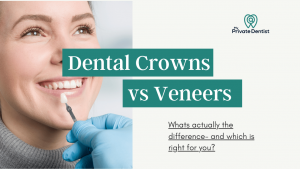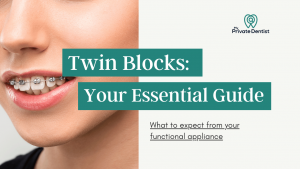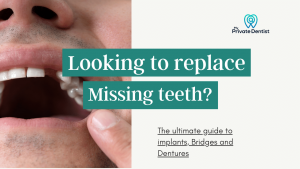These are my recommendations for the best toothpaste for gingivitis.
Choosing the ‘best’ toothpaste can be a challenge. With so many different brands and types, all claiming to improve the health of your teeth and gums- how do you know what really is the best toothpaste for gingivitis?
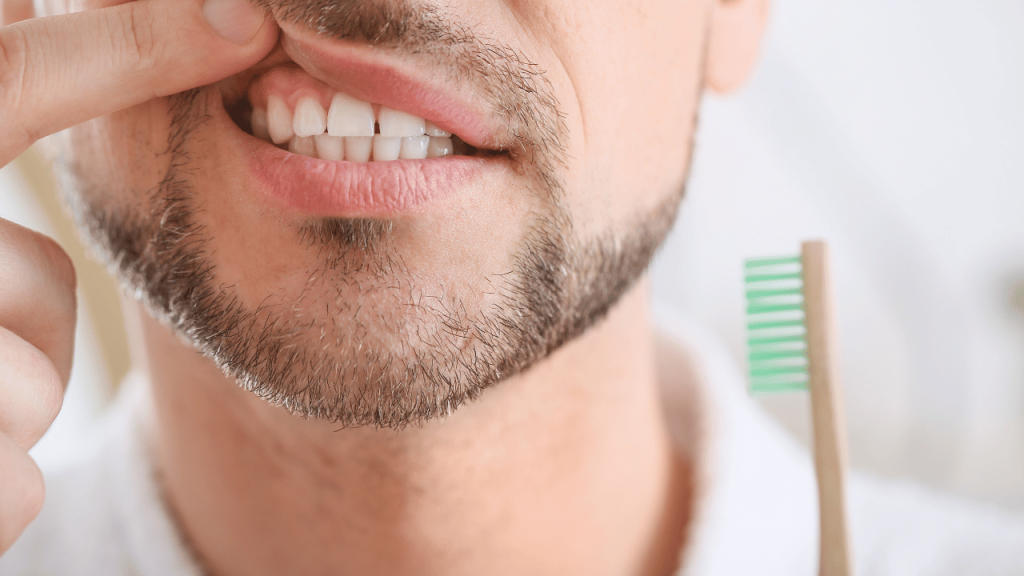
If you have gum disease, the most important thing is to have a good oral hygiene regime: effective brushing twice daily with an electric toothbrush, and interdental cleaning every day. This, combined with regular visits to the dentist, helps to ensure healthy gums and clean teeth.
When looking for a toothpaste for treating and preventing gingivitis, there are some key active ingredients that you should look for. These ingredients include stannous fluoride, xylitol and zinc citrate, and they work to improve inflamed gums and prevent plaque build up.
As a dentist, I recommend Colgate Sensitive Instant Relief because of the key active anti-gingivitis ingredients it contains.
In this article, I will share my top picks for a toothpaste that really helps to prevent gingivitis. I will cut through the confusing jargon and explain what you should look for on a toothpaste label when choosing the best toothpaste for gingivitis.
Best Toothpaste for Gingivitis
Why trust us? After helping thousands of patients over the last 10 years, we know what works. We tell you what the gimmicks are, so you can maintain your oral health for the best value for money.
We’ve carefully put together a list of toothpastes and an explanation of why we recommend them, to help you make an informed decision.
5 Top Picks
Best overall toothpaste for gingivitis- Colgate Sensitive Instant Relief Toothpaste
Best toothpaste for swollen gums – Oral-B Pro Expert Deep Clean Toothpaste
Best toothpaste for bleeding gums – Corsodyl Gum+ Breath and Sensitivity Toothpaste
Best toothpaste for sensitive or sore gums – Crest Gum Detoxify Deep Clean Toothpaste
Best toothpaste for advanced gum disease – Curaprox PerioPlus Support Toothpaste
Best overall toothpaste for gingivitis
Colgate Sensitive Instant Relief toothpaste
Why our dentists recommend this toothpaste
Colgate Sensitive is a great all round toothpaste suitable for daily use, that packs in all important key active ingredients to help treat and prevent gum disease. It provides sensitivity relief, promotes fresh breath and prevents tooth decay.
Most importantly, sodium fluoride help prevent the formation of bacteria and plaque, reducing the chances of developing gum disease. This toothpaste contains the total recommended fluoride content of 1450ppm.
Zinc oxide helps to prevent the formation of plaque and calculus, which are major contributors to gum disease. As it is antimicrobial, it helps to lower bacterial levels in the mouth, making your breath smell fresher too.
Pros
✅ Arginine technology combats sensitivity
✅ Anti-gingivitis key ingredient zinc oxide
✅ Prevents tooth decay
Cons
❌ Contains SLS, a foaming agent that can be a potential irritant for some
Best toothpaste for swollen gums
Oral B Pro Expert Deep Clean Toothpaste
Why our dentists recommend this toothpaste
Oral B is a widely recognised brand, and easily available from supermarkets and stores. We recommend the Pro Expert Deep Clean because if used twice daily, can prevent sore, swollen gums caused by gum disease.
Importantly, it contains the antibacterial and antiplaque ingredient stannous fluoride. This works to reduce the number of bacteria in the mouth, and prevents the formation of plaque and calculus- the main cause of gum disease. By stopping bacteria in its tracks, gums remain healthy.
Stannous fluoride also provides a protective barrier around exposed dentine on teeth, helping to prevent sensitivity caused by hot/cold stimuli.
Sodium fluoride helps strengthen the tooth enamel, making it more resistant to acid attacks and preventing tooth decay.
The inclusion of citric acid in the toothpaste provides additional antimicrobial benefits, as it also helps inhibit the growth of bacteria in the mouth
Zinc citrate in the toothpaste helps prevent the formation of calculus. This is beneficial for maintaining clean and healthy teeth, as tartar buildup can contribute to swollen, red gums and gingivitis.
Pros
✅ Well known brand
✅ Recyclable carton and tube
✅ Contains recommended fluoride content (1450ppm)
Cons
❌ Contains SLS, a potential irritant
Best toothpaste for bleeding gums
Corsodyl Gum + Breath and Sensitivity
Why our dentists recommend this toothpaste
Corsodyl Gum + is marketed as a specific formulation to treat gingivitis and bleeding gums. recommended, it contains antibacterial stannous fluoride and zinc chloride as the star ingredients, which work to reduce inflammation, and improve gum health by disrupting the structure of plaque, preventing its regrowth in the mouth.
Corsodyl mouthwash is well known for its effectiveness in treating gum disease. Their toothpastes work well too, but patients sometimes struggle with the taste. We like the new Corsodyl Gum + Breath and Sensitivity toothpaste, as not only is it great for promoting healthy gums, the peppermint and sweet spearmint flavour tastes good too.
Corsodyl Gum + toothpaste targets plaque bacteria deep within teeth, prevents sensitivity and even tackles bad breath, making it a great option for every day use.
Pros
✅ Contains stannous fluoride, a key ingredient to treat gum disease
✅ Formulation of stannous fluoride unlikely to cause staining
✅ Improved flavour peppermint and sweet spearmint
Cons
❌ Not suitable for children
Best toothpaste for sensitive or sore gums
Crest Gum Detoxify Deep Clean Toothpaste
Why our dentists recommend this toothpaste
Once again, we like this toothpaste for gingivitis due to the key ingredient: stannous fluoride. By including stannous fluoride, Crest Gum Detoxify toothpaste has anti-inflammatory properties and the ability to protect against tooth decay. With regular twice daily use, It can help reduce sensitivity and soothe sore gums.
Crest Gum detoxify also contains zinc citrate, which helps prevent the build up of plaque, promoting healthier gums and reducing inflammation that causes sore gums.
Specifically for sore gums, this toothpaste has an activated foam formulation, which is designed to penetrate hard-to-reach areas, including up to 4mm under the gum margin. This can aid in removing plaque and bacteria from areas that are difficult to access, promoting gum health.
It also has a cooling sensation on the gums, which helps to give a refreshing and soothing experience during brushing.
Pros
✅ Great flavour with cooling sensation to gums
✅ Mild and non minty
✅ Activated foam formulation, they claim to reach 4mm under the gum margin in hard to reach places.
Cons
❌ SLS can be an irritant for some. Seek an alternative SLS free toothpaste if you notice discomfort when using it
Best toothpaste for advanced gum disease
Curaprox PerioPlus+ Support Toothpaste
Important Active Ingredients For Gingivitis
Chlorhexidine digluconate (CHX) 0.09%: Antiseptic and disinfectant, reduced plaque formation and bad odours
Citrus Aurantium Amara (Citrox®/P formula): Antibacterial, anti-inflammatory
Sodium fluoride: Strengthens enamel
Xylitol: Pleasant taste and anti-plaque
PVP/VA: Dissolves plaque and forms protective film over the teeth and gums
Polyepsilon-Lysine: Antimicrobial
Why our dentists recommend this toothpaste
We recommend Curaprox PerioPlus+ Support Toothpaste for people dealing with advanced gum disease, because it has additional hard-working ingredients not found in the other toothpastes. The fluoride content is lower than I would usually recommend for regular use, but is particularly useful short-term, to treat and prevent later stages of gum disease.
Curaprox PerioPlus contains chlorhexidine digluconate (CHX), an antibacterial active ingredient. It is a strong antiseptic that works to significantly reduce the amount of bacteria-containing plaque in the mouth. By controlling bacterial growth, it helps improve gum health. CHX is not found in any other toothpaste, but is in some mouthwashes such as corsodyl.
Advanced gum disease can lead to tooth sensitivity and discomfort. Curaprox PerioPlus+ Support Toothpaste is designed to be non-mint and SLS-free, which can be more gentle for sensitive gums. SLS is used for the foaming effect in toothpaste, but can cause irritation for some people. Being SLS-free, this toothpaste reduces the likelihood of any adverse reactions, making it suitable for those with sensitivity.
The toothpaste contains additional active ingredients beneficial for gum health. Hyaluronic Acid and Chlorhexidine work together to support gum health and reduce inflammation associated with gingivitis. Sodium Fluoride helps prevent tooth decay, and Xylitol contributes to caries prevention.
Pros
✅ Packed with antibacterial key active ingredients
✅ CHX is a strong antiseptic
✅ SLS free
✅ Gentle flavour
Cons
❌ Risk of tooth discolouration caused by chlorhexidine staining
❌ Low F content (230 ppm F), not for everyday use
❌ Not suitable for children
Buying guide: What To Look For In Toothpaste for Gingivitis
What is gingivitis?
Gingivitis, the early stages of gum disease, is a very common condition in which gums become irritated in response to plaque build up. Gums appear red, raised or swollen and often bleed when brushing or flossing. Fortunately the process is reversible, by adopting a good oral hygiene routine. This means effective and regular use of an electric toothbrush, and a stannous fluoride containing toothpaste.
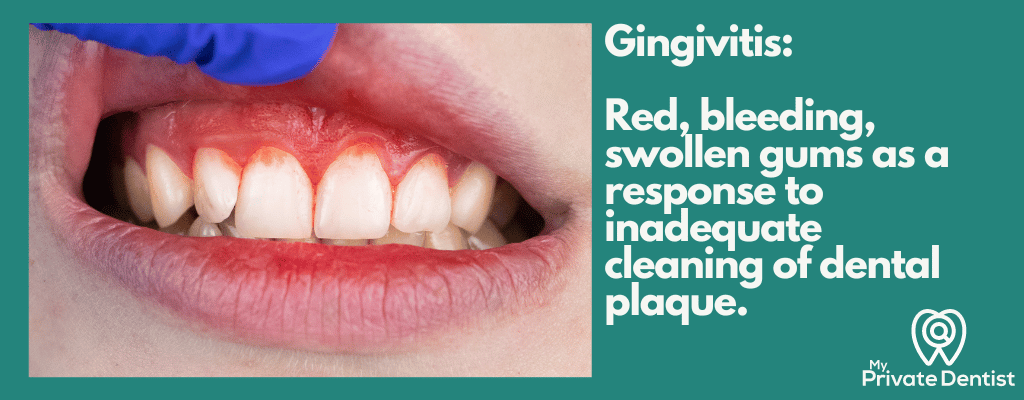
Periodontal disease develops as a later or more advanced stage of gum disease, when gingivitis is left untreated. Periodontal disease causes irreversible damage to gums, and the underlying bone in which your teeth are held. Bone loss can occur in response to the persistent bacteria in plaque, and can cause teeth to become wobbly over time. The damage from periodontal disease cannot be reversed, and once bone has been lost we can’t grow it back. Treatment aims are to improve oral health, reduce bacteria in plaque build up and halt disease progress.
How do you treat gingivitis?
The second we finish brushing, we start to develop a layer or film of plaque on our teeth and around the gum margin again. If brushing effectively twice daily, this plaque build up doesn’t cause much of a problem. However If you don’t do this, or if you don’t have an effective technique, plaque accumulates and starts to irritate the gums. If you have red, swollen, tender gums that bleed easily, chances are you have gum disease.
For optimal oral health, you need to be brushing with an electric toothbrush and fluoride containing toothpaste for 2 mins a time, 2 times a day. And floss daily. The most important thing for healthy gums is your technique of brushing, the way you physically remove the plaque.
Toothpaste can provide additional help in the fight against gum disease, with some specific pastes containing antibacterial active ingredients. Look for toothpaste with stannous fluoride for the best protection against gingivitis.
Key ingredients to look for in the best toothpaste for gingivitis
Next time you’re looking for toothpaste to buy, skip the claims on the box and cut straight to the label. The best toothpaste for gingivitis should be antibacterial, soothing, gentle, and prevent calculus build up.
Anticavity and Antigingivitis: Fluoride
You should always use a toothpaste that contains fluoride. Fluoride plays an important role in preventing tooth decay. It does this by bonding to the outer enamel layer of teeth, and in doing so making teeth more resistant to breakdown caused by acid attacks after food and drinks.
It also has some benefits to combat gingivitis.
Look for toothpaste containing 1000-1450 ppm (parts per million) fluoride. This is widely available, and most toothpastes bought in supermarkets contain fluoride, though not all- so it is important to check.
If you’re at high risk of tooth decay, your dentist may prescribe toothpaste with an even higher concentration of fluoride- up to 5000 ppm if aged 16+.
Fluoride is added to toothpaste in two forms: Sodium Fluoride or Stannous Fluoride.
Stannous Fluoride
Stannous fluoride has additional properties that make it an essential ingredient in a toothpaste for gingivitis.
It is antibacterial: meaning that it can stop the growth of bacteria in plaque- the main cause of gingivitis, and bad breath. By reducing the amount of bacteria in the mouth, stannous fluoride promotes a healthier mouth.
It also prevents the formation of plaque in your mouth, making it easier to remove through regular brushing and flossing.
Stannous fluoride can help with tooth sensitivity too. Gingivitis can lead to gum recession, exposing more sensitive roots of your teeth. Stannous fluoride works to form a protective layer over those exposed areas, acting as a shield to reduce sensitivity.
Desensitising Agents: Potassium Nitrate/Strontium Chloride
If you’re dealing with gingivitis and sore, sensitive gums, it’s worth considering a toothpaste with desensitising agents like potassium nitrate or strontium chloride. These ingredients work by blocking pain signals in the teeth and gums, providing relief from sensitivity. Potassium nitrate is particularly effective for soothing inflamed nerves and can be especially helpful if you have receding gums and exposed cementum. Sensodyne toothpaste, which contains potassium nitrate, is a popular choice for those looking to improve their symptoms.
Gentle abrasives: Hydrogen peroxide/Calcium Carbonate
The best toothpaste for gingivitis contains mild abrasive agents, such as hydrated silica, or calcium carbonate, that can help remove plaque and surface stains without being overly harsh on sensitive gums.
Abrasive ingredients added to toothpaste include hydrogen peroxide, baking soda, calcium carbonate, silicate aluminium carbonates or aluminium hydroxide. Their main purpose is to remove surface stains and break up bacterial colonies. Whitening toothpastes often include abrasives, which are slightly more gritty to remove surface stains. Hydrogen Peroxide is the active ingredient found in whitening gels, however is found in a very low concentration in toothpaste so is unlikely to change the shade of teeth. It is useful for bad breath, however, as it eliminates bacteria in your mouth
Flavour: Xylitol
Xylitol is a naturally occuring sweetener added to improve the flavour of toothpaste, without any risk of causing dental decay. It also reduces plaque and inhibits bacteria that causes bad breath.
Anti-calculus: Zinc citrate, pyrophosphates
Calculus (hardened plaque) buildup can contribute to gum disease. Toothpaste with ingredients like pyrophosphates or zinc citrate can help prevent calculus formation, minimising the risk of gum problems.
Antimicrobial Agents: Chlorhexidine
Antimicrobial agents: Look for toothpaste that contains antimicrobial agents such as triclosan, chlorhexidine, or essential oils like tea tree oil, thymol, or eucalyptol. These ingredients help reduce the number of bacteria in the mouth and control the growth of plaque-causing bacteria.
Anti-inflammatory agents
Look for toothpaste with anti-inflammatory agents such as aloe vera, green tea extract, or chamomile. These ingredients can help reduce gum inflammation and soothe irritated gums.
Be wary of Sodium Lauryl Sulphate (SLS) Surfactant
This is the ingredient in your toothpaste that makes it foamy and helps to coat all of your teeth surfaces when you brush. Sodium lauryl sulphate (SLS) is a common surfactant found in toothpastes. If you have gingivitis and experience sensitive, or sore gums, you may want to avoid a toothpaste containing SLS as it may make it worse. Although not definitive, there are some studies that suggest that SLS in toothpaste can be irritating to your gums, and cause inflammation.
There are several SLS-free toothpastes available, with alternative surfactants, such as sodium lauryl sarcosinate or cocamidopropyl betaine.
What are the other ingredients in toothpaste for?
Several ‘inactive’ ingredients are also included in toothpaste. They have various uses for making toothpaste last well, and provide flavour and texture. Here are some common ingredients you may see listed on your tube.
Preservatives
Preservatives are included in toothpastes to keep them fresher for longer, and have strong antimicrobial properties to prevent contamination of your tube. You may find:
- Sodium Benzoate
- Potassium Sorbate
- Sodium Phosphate
- Methylparaben
Pigments
Pigments are used sometimes in toothpastes, to make them appear a certain colour. Common pigments are often listed in the ingredients with a CL followed by a number. They include:
- CL77891 Pink colouring
- CL 74160 Green colouring
- Cl 42051 Blue colouring.
Artificial Sweeteners
These aim to improve the taste of your toothpaste and come in the form of:
- Sucralose
- Sodium Saccharin
Buffers
Buffer ingredients are added to balance pH of the toothpaste.
- Sodium Hydroxide
- Disodium Phosphate
Thickening agents
These are used for the optimal texture
- Xantham Gum
- Cocamidopropyl Betaine
How to clean your teeth
To avoid gum disease, we need to effectively remove plaque building up on your teeth. To do this you need 2 things:
- An excellent brushing technique
- Regular dental check ups
What is the correct way to clean your teeth?
- Get into the groove of flossing: Use interdental aids every day. You can use flossettes, interdental brushes, or even a water flosser like a WaterPik to clean between your teeth.
- Unveil the plaque with disclosing tablets: Pop a small purple disclosing tablet into your mouth, chew it, and swish it around. This tablet will dye any plaque, making it easier to spot and remove. You can use it before or after brushing to ensure you haven’t missed any plaque.
- Opt for a toothpaste with disclosing properties: Piksters plaque disclosing toothpaste is a fantastic option. It helps reveal plaque so you can banish it effectively. (Link)
- Embrace the power of fluoride: Use a pea-sized amount of toothpaste containing fluoride (for kids under 6, a smear will do) on a wet electric toothbrush. Look for a toothpaste with 0.45% stannous fluoride, as it’s great for gingivitis and fights cavities
- Time for two-minutes: Brush your teeth for a full two minutes, twice a day. Focus on the gum line, where the tooth meets the gum, and make sure you cover all surfaces of your teeth (front, back, and biting surfaces).
- Be gentle if your gums are sensitive: If your gums are feeling tender, opt for a toothbrush with soft bristles and a toothpaste specifically designed for sensitivity. Your gums will thank you for the extra TLC.
- Spit, don’t rinse: After brushing, spit out the excess toothpaste, but skip the rinsing. This allows the active ingredients in the toothpaste to keep working their magic. Think of it like applying a nourishing moisturiser and leaving it on for maximum benefit.
- Freshen up with an antibacterial mouthwash: Grab an alcohol-free mouthwash containing fluoride for an extra boost. Swish it around your mouth at a different time from brushing to keep your breath fresh.
- Schedule regular dental visits: Make sure to visit a dentist or hygienist for personalised advice
Patients Often Ask…
Here are some frequently asked questions about gingivitis and brushing.
How do you avoid gum disease in the first place?
Preventing gum disease (or periodontal disease) is crucial for maintaining good oral health. Here are some tips to help you prevent gum disease:
- Brush like a pro: Make it a habit to brush your teeth properly at least twice a day using a soft-bristled toothbrush and fluoride toothpaste. Give attention to cleaning along the gumline and all tooth surfaces.
- Floss: Don’t forget to floss daily! It helps remove plaque and food particles hiding between your teeth and along the gumline. Take it easy and be gentle to avoid irritating your gums.
- Freshen up with mouthwash: Incorporate an alcohol-free, antimicrobial mouthwash into your routine.
- Choose a tooth-friendly diet: Fill your plate with a balanced diet that includes plenty of fruits and vegetables. Minimise sugary foods and drinks, as they can contribute to plaque formation.
- Kick bad habits: Limit tobacco and alcohol use. Smoking and chewing tobacco are risk factors for gum disease, and excessive alcohol consumption can also affect your gum health.
- Stay hydrated: Drink plenty of water to keep your mouth hydrated and stimulate saliva production. Saliva helps wash away food particles and bacteria, keeping your gums happy.
- See your dentist: Regular dental check-ups and professional cleanings are essential. Your dentist can spot early signs of gum disease and provide proper treatment if needed.
- Know your risks: Be aware of factors that increase your vulnerability to gum disease, such as hormonal changes, certain medications, genetics, and medical conditions like diabetes. Take extra care of your oral hygiene if you have these risk factors.
- Relax: Stress can weaken your immune system, making you more susceptible to gum disease. Find healthy ways to manage stress, like exercising, meditating, or indulging in hobbies that help you relax.
- Trust your instincts: Keep an eye on your gums and notice any changes like swelling, redness, bleeding, or persistent bad breath. If something feels off, don’t hesitate to reach out to your dentist for a chat.
Remember, taking care of your gums is just as important as caring for your pearly whites.
What is a good fluoride free toothpaste for gingivitis?
I generally recommend using a fluoride-containing toothpaste for optimal oral health. However, if you prefer a fluoride-free option, you might consider trying Biorepair Gum Protection toothpaste.
Biorepair Gum Protection toothpaste is formulated with an active ingredient called Microrepair, which contains hydroxyapatite crystals. These crystals work to strengthen tooth enamel and have antibacterial and anti-plaque properties. Additionally, the toothpaste includes hyaluronic acid, which they claim helps protect sensitive gums.
While fluoride is typically recommended for its cavity-fighting benefits, Biorepair Gum Protection offers an alternative approach to oral care without fluoride. Keep in mind that fluoride has been extensively studied and proven to be effective in preventing tooth decay, so it’s important to discuss with your dentist or dental professional to ensure you’re making the best choice for your oral health needs.
Can you use whitening toothpaste if you have gingivitis?
Well, technically, you can, but I’d say it’s better to focus on treating the gingivitis first. There are some whitening toothpastes out there that have ingredients to help with gingivitis, and little abrasive particles that can scrub away surface stains. They won’t change the colour of your teeth, just remove some staining.
If you’ve got gingivitis, it’s generally a good idea to hold off on the whitening toothpaste until your gums get better. Whitening toothpaste usually has gritty particles or chemicals that can be harsh on sensitive or inflamed gums.
It’s important to focus on getting your gums healthy before worrying about whitening your teeth.
Talk to your dentist about treating gingivitis. They might suggest a professional cleaning, some scaling, or other treatments to get your gums back on track.
In the meantime, pick a toothpaste that’s made for sensitive gums or gingivitis. These toothpastes are gentle on your inflamed gums and can help reduce plaque and gum inflammation.
Is there a difference between gingivitis and periodontitis?
Yes, and it is important to understand the difference between gingivitis and periodontitis. They’re both forms of gum diseases, but they vary in terms of how severe they are and how much damage they can do to your mouth.
Gingivitis is the milder one. It’s the early stages of gum disease, and is reversible, meaning you can totally get rid of it. It happens when plaque builds up along your gum line, causing inflammation. You might notice red, swollen, and tender gums that bleed easily when you brush or floss. Luckily, at this early stage, gingivitis doesn’t cause any damage to the bone or connective tissue that hold your teeth in place.
Treating and preventing gingivitis is all about good oral hygiene. Brushing, flossing, and getting regular cleanings from your dentist can get your gums back in shape.
Periodontitis is considered as a more advanced stage of gum disease. It’s what happens when gingivitis isn’t treated or managed properly. The infection and inflammation spread beyond the gums and cause irreversible damage to the support structures of your teeth, like the bone and connective tissues.
In periodontitis, deep pockets form at the gum margin, between your gums and teeth, making a cosy home for bacteria. They keep piling up plaque and hardened plaque (or calculus). It starts destroying the bone and tissues that hold your teeth steady, and if left untreated can lead to loose teeth.
Common signs of periodontitis include chronic bad breath, receding gums, sensitive gums, loose or drifting teeth, and maybe even pus or abscesses between your teeth and gums.
Treatment for periodontal disease often requires professional input. Again, excellent oral hygiene is so important to halt and prevent the disease process from progressing. Your dentist might do a deep cleaning with an ultrasonic scaler, prescribe antimicrobial treatments, or even advise gum surgery to minimise damage to tissues and bone.
Remember, both gingivitis and periodontitis are preventable. Just keep up with good oral hygiene, see your dentist regularly, and don’t wait to get help if you notice any gum issues.
Does stannous fluoride cause staining?
Stannous fluoride doesn’t usually cause staining with the toothpaste formulations available today. In the past, it could happen if you used too much or didn’t use the product correctly. You might see some brown or yellow stains on your teeth, especially near the gumline or areas with enamel defects. These stains are called extrinsic stains and can be removed with professional dental cleanings or certain whitening toothpastes.
To avoid any potential staining when using stannous fluoride containing products:
- Follow the instructions: Just use the recommended amount of toothpaste or mouthwash. Don’t go overboard.
- Spit it out: After brushing or rinsing, make sure to spit out the residue and avoid swallowing it.
- Keep up good oral hygiene: Brush and floss properly to keep plaque at bay and minimise the chances of staining.
- See your dentist regularly: Regular dental check-ups and cleanings are key. They can help prevent plaque buildup and address any concerns about staining or other oral health issues.
In my opinion, the benefits of using toothpaste with stannous fluoride for reducing gum inflammation and preventing tooth decay are more significant than the potential risk of staining. While staining can occur in some cases, it is usually a minor issue that can be addressed with professional cleanings or whitening toothpastes.
Our Verdict
If you’re dealing with sore, bleeding gums and sensitivity from gingivitis, it’s a good idea to make sure your tooth brushing routine is regular and effective.
Using a specific toothpaste for gingivitis can help to reduce bacteria and plaque build up, one of the main causes of gum disease.
We recommend Colgate Sensitive Instant Relief as the best overall toothpaste for gum disease. It contains the recommended 1450ppm fluoride, and is packed with anti-gingivitis active ingredients. It’s gentle enough for daily use, promotes gum health and even tackles sensitivity.







